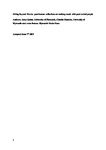Living Beyond Words: post-human reflections on making music with post-verbal people
| dc.contributor.author | Quinn, Jocey | |
| dc.contributor.author | Blandon, C | |
| dc.contributor.author | Batson, A | |
| dc.date.accessioned | 2019-06-27T15:12:12Z | |
| dc.date.issued | 2019-08-09 | |
| dc.identifier.issn | 1753-3015 | |
| dc.identifier.issn | 1753-3023 | |
| dc.identifier.other | 0 | |
| dc.identifier.uri | http://hdl.handle.net/10026.1/14480 | |
| dc.description.abstract |
Background: This paper draws on a longitudinal ethnographic study of music-making with "post-verbal" people: those with stroke, learning difficulties, acquired brain injury, dementias or autism. Methods: Using embedded observation, arts workshops, interviews with families and carers and focus groups with Music Leaders, the project traced how inclusive music-making happens with "post-verbal" people. It used post-human theory to illuminate and explore processes and benefits. Results: This paper fuses the practical and theoretical aspects of making music with post-verbal people, to understand both how it happens, and, what it signifies. It shows how post-verbal people use music to communicate and demonstrate their capacities, and analyses how those working with them use music to foster a sense of inclusion and belonging. Conclusions: By writing in collaboration across academia and community music practice the paper makes new and important contributions to both post-human thinking and capacities in learning, arts and health. | |
| dc.format.extent | 73-86 | |
| dc.format.medium | Print-Electronic | |
| dc.language | en | |
| dc.language.iso | en | |
| dc.publisher | Taylor & Francis (Routledge) | |
| dc.subject | Music | |
| dc.subject | dementias | |
| dc.subject | stroke | |
| dc.subject | post-human | |
| dc.subject | post-verbal | |
| dc.title | Living Beyond Words: post-human reflections on making music with post-verbal people | |
| dc.type | journal-article | |
| dc.type | Journal Article | |
| dc.type | Research Support, Non-U.S. Gov't | |
| plymouth.author-url | https://www.webofscience.com/api/gateway?GWVersion=2&SrcApp=PARTNER_APP&SrcAuth=LinksAMR&KeyUT=WOS:000631289600002&DestLinkType=FullRecord&DestApp=ALL_WOS&UsrCustomerID=11bb513d99f797142bcfeffcc58ea008 | |
| plymouth.issue | 1 | |
| plymouth.volume | 13 | |
| plymouth.publication-status | Published | |
| plymouth.journal | Arts & Health | |
| dc.identifier.doi | 10.1080/17533015.2019.1652194 | |
| plymouth.organisational-group | /Plymouth | |
| plymouth.organisational-group | /Plymouth/Faculty of Arts, Humanities and Business | |
| plymouth.organisational-group | /Plymouth/Faculty of Arts, Humanities and Business/Plymouth Institute of Education | |
| plymouth.organisational-group | /Plymouth/REF 2021 Researchers by UoA | |
| plymouth.organisational-group | /Plymouth/REF 2021 Researchers by UoA/UoA23 Education | |
| plymouth.organisational-group | /Plymouth/Research Groups | |
| plymouth.organisational-group | /Plymouth/Research Groups/Institute of Health and Community | |
| plymouth.organisational-group | /Plymouth/Research Groups/Plymouth Institute of Health and Care Research (PIHR) | |
| plymouth.organisational-group | /Plymouth/Users by role | |
| plymouth.organisational-group | /Plymouth/Users by role/Academics | |
| dc.publisher.place | England | |
| dcterms.dateAccepted | 2019-06-08 | |
| dc.rights.embargodate | 2020-8-8 | |
| dc.identifier.eissn | 1753-3023 | |
| dc.rights.embargoperiod | Not known | |
| rioxxterms.version | Accepted Manuscript | |
| rioxxterms.versionofrecord | 10.1080/17533015.2019.1652194 | |
| rioxxterms.licenseref.uri | http://www.rioxx.net/licenses/all-rights-reserved | |
| rioxxterms.licenseref.startdate | 2019-08-09 | |
| rioxxterms.type | Journal Article/Review |


